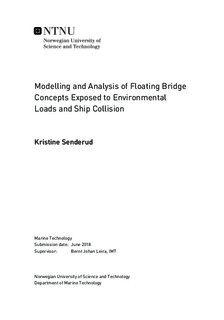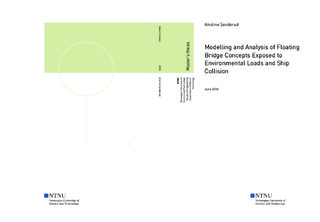| dc.description.abstract | The need for improving the infrastructure in Norway meets challenges when developing solutions to cross the wide and deep fjords along the coastline. The Norwegian Public Roads Administration (NPRA) is behind the ongoing project "The Ferry Free Coastal Route E39" where by replacing seven ferry crossings with floating bridges and submerged tunnels, today s travel- and transportation time between Kristiansand and Trondheim will be reduced from 21 to 11 hours. The fjords to be crossed are wide and deep with water depths up to 1300 meters. The project has faced major economic and technological challenges related to the solutions when advanced offshore technology and existing bridge solutions have been combined to establish concepts that satisfy the design criteria. This has lead to an increase in product cost from 150 to 340 billion NOK. The future project progress will depend on economic constraints and development of future technological solutions.
This thesis carries out a concept study of a floating bridge concept for crossing the Halsafjord along E39. The planned distance reaches 2.1 km from Halsneset to Urdneset. The concept is based on the proposed curved bridge for crossing the 4 km long Bjørnafjord. The thesis is carried out for the NPRA with the long-term goal of reduced response at lower costs than presented for the Ferry Free Coastal Route E39 project up until today. Two concepts are analysed, where a curved bridge girder is supported by the undercarriage of offshore jackets, cable stay bridges and floating pontoons.
Concept 1, I-jacket: Curved bridge supported by one steel jacket placed 400 m from the east abudment. The span between the abudment and jacket is given additional support from cable stays. The remaining bridge girder is supported by nine floating pontoons.
Concept 2, II-jacket: Curved bridge supported by two steel jackets, each placed 400 m from the east and west abudments. The span between the jackets and the shoreline is given additional support from cable stays. The bridge girder between the jackets is supported by six floating pontoons.
The concepts are modeled in the finite element software ANSYS Mechanical APDL 18.2. Properties to represent global mass and stiffness properties of the jacket are obtained from analyses using the USFOS software and implemented in the ANSYS model.
Response from a static analysis during environmental loading conditions including wind, current and tidal variation is measured for both concepts. A regular wave analysis is performed on the II-jacket bridge for characteristic waves in the relevant area, as this concept indicated more careful considerations regarding dynamics. The static and regular wave analysis show that the response is within the design criteria limits, except for a small exceedance in vertical deflection during low tide, and a small exceedance for the acceleration component during wave conditions with a 1 year return period. Neither of the concepts exhibit critical response in terms of moments or stresses, but cyclic loading and fatigue should be assessed in further work. Considering the exceeded criteria and modeling approach, redesign and further work on hydrodynamics will be necessary.
A modal analysis shows that the first natural periods range from 82 seconds and lower (I-Jacket) and 54.5 seconds and lower (II-Jacket). Swell generated waves with 1, 100 and 10 000 year return periods overlap when the wave period is between 6 and 18 seconds for both concepts. For local wind generated sea, lower modes coincide. The first dynamic modes indicate that low frequency induced dynamic response will be important to assess as this indicates chance of resonant response.
A ship collision scenario is modeled in USFOS to measure the jackets response when exposed a collision with a RORO-vessel of similar mass and velocity as those that operate in the Halsafjord. The collision energy is 209 MJ. Results from the ship collision analysis indicate that jacket suffers severe damage, which may cause critical damage to the bridge. A full dynamic analysis of ship collision with a global bridge model must be performed to substantiate whether the bridge will survive or collapse in case of a collision.
The analyses performed in this thesis are insufficient to verify that the concept is feasible, but gives an indication of the global static and dynamic behavior of the structure as well as highlighting of further work. | |

